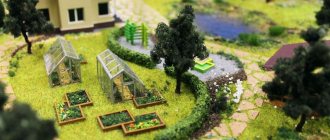The art of bonsai, although considered a native Japanese tradition, actually originated in China about 2 thousand years ago. Later it migrated to Europe and is still a fashionable trend in design. In the traditional sense, bonsai is the growing of trees in small pots or on trays. Its purpose is to inhibit the growth of the root system and crown, which turns a genetically large tree into a dwarf plant of a rather unusual appearance.
Despite the fact that “bonsai” is translated from Chinese as “tree on a tray,” modern landscape designers manage to grow this miracle in the garden. And not just in containers, but in open ground! How, based on the ancient bonsai technique, to grow a dwarf tree in the garden? Our article will talk about this.
Choosing a tree for growing bonsai
As a bonsai plant, you can choose any tree that is common in your area and overwinters in the open ground. As for the beauty of the future work, a miniature pine tree can give your garden a special Japanese flavor. It is better to choose mountain pine, which is not large in size anyway - in this case, shaping will be easier for both you and the tree. Common spruce, thuja, juniper, and cypress can also be given an unusual shape. Among the deciduous species, fruit trees are widely used: apple trees, pears, plums, cherries. With proper pruning, these bonsai will continue to bloom and set fruit in the spring! In addition to fruit trees, you can choose almost any deciduous tree from the middle zone, for example, chestnut, linden, oak, willow, birch, call, rowan, etc. If you live in more southern areas, then feel free to add cedar, boxwood, and privet to this list , cotoneaster and many other species that do not winter in mid-latitudes.
Bonsai can even be made of pine
LiveInternetLiveInternet
Today we’ll talk about some ways to form a plant, using the example of Scots pine. By breaking out excess buds, you can plan the required number of new shoots and the direction of their growth. Thus, we refuse to further trim unnecessary branches and do not injure the tree, because any pruning is stressful for the plant. Breaking out pine buds can be done in the fall, when they are fully formed, or in early spring, before they swell. The photo below shows the apical buds of a pine tree. If everything is left as it is, then next year, in this place, a central conductor (continuation of the trunk) will grow, surrounded by three side branches. But, according to our plan, we need to get one side branch on the left side and continue the growth of the pine upward. To do this, we carefully break out the extra buds, as shown in the photo.
As a result, there are two buds left on the pine tree, of which the right one will grow upward, and from the left one we will get a lateral branch. Pinching shoots when forming pine bonsai. By pinching pine trees, we regulate the annual growth of new shoots on the plant. It is known that the main growth force of a pine tree is directed primarily at the top, and often the lower branches give small increments. With the help of pinching, you can subordinate all the branches in terms of growth strength, limiting the growth of some and stimulating the growth of others. For example, a pine tree, which is formed in the form of a double trunk. From the photo you can trace the stages of development and formation of the plant. Over two seasons, a second trunk was formed from a side branch, and this year it caught up in growth with the main trunk, the growth of which was restrained by pinching.
Pinching is carried out on green shoots (candles) until the needles bloom on them. This is approximately the beginning of June. The shoots are easily broken off with fingernails or cut off with pruning shears.
To fix and give the trunks a certain shape, braided aluminum wire is used. The photo below shows how it is planned to grow a garden bonsai from a pine tree. We will try to do without pruning branches and shape the tree by breaking out excess buds and pinching shoots. Another example of how to grow pine bonsai.
We already showed this photo of a garden bonsai last year. According to the idea, a round ball will be formed on the left branch, and the right branch and the central conductor will be driven upward. But our pine was not lucky. In winter, an elk came into the territory and bit off the right branch. Apparently there weren't enough vitamins. In addition to this pine, 5 more pines were damaged. And he ate fresh growths everywhere. We'll have to cover the tops next winter. The result is a pine tree like this. Its height is approximately 120 cm. It’s good that an apical bud has appeared on the stub of the right branch, we will drive it further. This is how we imagine our pine garden bonsai in 3-4 years. source
Garden bonsai planting technique
Despite the fact that garden bonsai will be grown in open ground, it will not see freedom. In fact, it’s a stretch to call this open ground truly “open.” Our task is to bring the living conditions of a garden tree closer to container living, that is, to limit the growth of roots as much as possible. Due to this, the upper part of the plant is depressed, acquiring a dwarf appearance.
Trimming roots and branches of a garden bonsai
The first step is to slightly trim the root system of the young seedling, shortening the central root. After this, a hole is dug for planting, and a wide stone or concrete slab is placed at the bottom. You can simply fill the bottom with concrete - this is done in order to limit the growth of tree roots deeper. A layer of earth 30-40 cm thick is poured on top of a solid base. In garden stores you can find special soils for growing bonsai, for example, Akadama. If you don’t find anything like this, then take any infertile, light soil - it will also be quite suitable. The main thing is that it is not “greasy” black soil, which can enhance the growth of the tree, and not slow it down.
The young tree is planted on this layer and covered with soil. Now you need to let the seedling take root, so its roots are not touched for a year. Starting next spring, they begin pruning the roots, cutting them around the trunk with a shovel. Remember that the tree must continue to feed in order not to die, and this is only possible if it is not fully pruned. That is why you cannot cut the roots in a circle. It is quite enough to cut only a quarter of the roots in the first year (for example, on the north side of the trunk), the next year - another quarter (on the south side), etc.
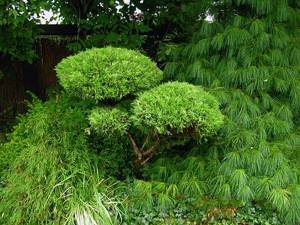
Young bonsai tree in the garden
Differences in the concepts of nivaki and garden bonsai
The art of changing the shape of the crown and trunk of a tree first appeared in Japan and became known as the Niwaki style. On its basis, many substyles have emerged, each of which describes in detail the technique of a particular modification.

Later, this art began to win its fans from other countries of the world and, thus, spread throughout the world.
The nivaki style also came to Europe, where it already had its own European school of ornamental gardening. Based on nivaki and local conditions, a new style emerged, which became known as garden bonsai.
It turns out that if nivaki is a purely Japanese art of changing the shape of the crown and trunk of trees for decorative purposes, then garden bonsai is a synthesis of nivaki and European techniques of decorative gardening in relation to European conditions.
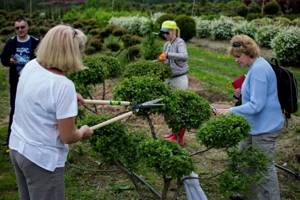
Hence, the Japanese and European styles are largely similar, but there are also differences: when processing, Europeans prefer to use fast cutting, while the Japanese prefer slow trimming of tree branches.
Related article: Design of a wooden house inside in photos and videos
In fact, these styles differ not only in technique, but also from a philosophical point of view. It is generally accepted that the Niwaki style demonstrates the victory of natural forces over plants, while garden bonsai demonstrates the victory of man over nature.
Correct formation of bonsai
After the tree is planted, you can begin to form the trunk and crown of the bonsai. The most important activities are pruning and pinching, with the help of which the crown of the tree is given the desired shape. Pruning is carried out once a year, preferably at the end of winter. At the same time, all main shoots and large branches that do not fit into the final desired appearance of the bonsai are cut off. Pinching is done more often, sometimes several times during the summer. By pinching bonsai, they achieve the growth of new, thin shoots with smaller leaves.
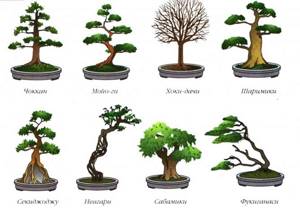
Methods for forming a bonsai crown
The art of bonsai is associated not only with the transformation of an ordinary tree into a dwarf one, but also with its artificial aging. In other words, even if the bonsai on your site has only been growing for five years, it should look like a hundred-year-old baobab.
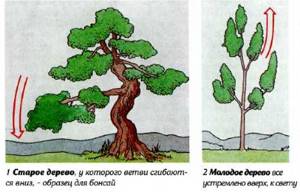
Position of branches of an old tree and a young one
To achieve a similar effect, you can bend the branches of the tree down, then it will look more mature. To do this, it is enough to tie any heavy objects to the branches, then gradually the crown will take on a drooping appearance and the weights can be removed.
Another popular way to give the trunk and branches the desired shape is to use copper wire. To do this, the bonsai is bent in the desired direction, then one end of the wire is fixed on the surface of the ground and they begin to wind it around the trunk to the place where the bend is supposed to be made. After this, the tree is bent and the wire continues to be wrapped around it onto a section of the trunk or branch after the bend has been completed.
The fixing structures remain on the tree for about six months. During this time, the crown or trunk is securely fixed in the selected position and does not change its shape after removing the wire or weights.

Forming a bonsai using wire
This simple technology will allow you to grow bonsai in the garden. In size it will be slightly higher than container analogues created using traditional technology. In any case, 1.5 m is the limit for such garden trees, which can diversify your landscape design and give it an unusual Japanese flavor.
Bonsai secrets
To date, more than 1,200 books have been written on bonsai techniques, as in any other art form, it is impossible to standardize technologies and develop universal recipes. There is no limit to perfection, so you can learn the basics, but you will have to feel the nuances yourself. Here are a number of basic bonsai rules that anyone who wants to try their hand at such an extravagant hobby should know:
- to grow miniature copies of trees, it is better to use local species;
- the bonsai technique can be applied to both indoor and outdoor trees;
- a tree artificially grown in a pot needs to recreate natural conditions as much as possible (temperature, humidity, soil type, light, etc.);
- To grow trees using the bonsai technique, cuttings are used - one of the methods of vegetative propagation of plants;
- plant growth is regulated mainly through the formation of a flat root system and special pruning of the trunk and branches;
- on average, plants need to be replanted once every two years, before the spring movement of sap resumes (at the same time, the root system is unraveled, cleaned of diseased roots, thinned out if necessary, etc.);
- changing the shape of the trunk is achieved through the use of aluminum or copper wire or trimming technology;
- in order for the leaves to look commensurate with the proportions of the trunk, they need to be torn off in a timely manner (in place of one large leaf, in this case several small ones grow);
- cut areas must be covered with healing varnish, while the main branches can be cut off no more than once a year, young shoots and small branches can be cut as often as desired at any time of the year;
- in order to completely stop the growth of a tree (ready bonsai), when replanting, the root system must be cut back by about one third;
- the thickness of the main bonsai trunk should be at least one sixth of its length;
- Bonsai plants need care even more than their “wild” counterparts: watering, fertilizing, preparing for winter, etc.
These are just some of the basic rules of bonsai technique. In fact, each operation is worthy of its own section or several chapters of the book.
Basics of garden bonsai techniques
Let us dwell on the more familiar and widespread technique among Europeans for garden bonsai. Using the technique described below, you can personally obtain in your garden trees of the same bizarre shape that Japanese gardens are so famous for.

- For garden bonsai, a strong, healthy tree is selected so that it is able to withstand all changes and does not die during processing.
- With the onset of spring, all unnecessary branches are then cut off from the tree, leaving only those on which it is subsequently planned to carry out the foliage formation technique.
- After this, all leading shoots and almost all whorls are removed, leaving only a certain number of them in such a way that they gradually decrease as they move from the base of the tree to the top.
- Now, through the use of various spacers and stretchers, the direction of branch growth is controlled. It is important to obtain their uniform arrangement around the axis of the tree trunk.
- The next year, all whorls on the branches are removed. Only the outermost one and the whorl located next to it (if there is one) are left. The idea of this stage is to enhance the growth of branches and foliage at the site of formation of future plates in order to obtain larger plates.
- In subsequent years, those whorls that remain are cut to 1/3 of their length in order to form the intended shape of the plates.
- Maintenance and care mainly boils down to thinning and trimming in order to prevent excessive growth of the plates and their loosening. On average, about six haircuts are performed per year.

Garden bonsai is an art that can take quite a long time to master. Sometimes one minor mistake can immediately cancel out all the work or it will be extremely difficult to correct in the future.
Related article: How to measure an interior door correctly


